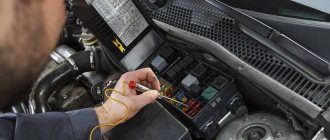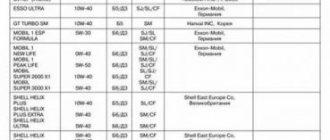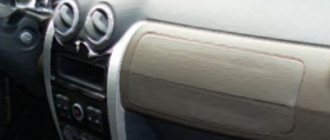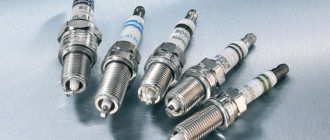A dead battery that refuses to start the engine in the morning is a situation familiar to every motorist. Under normal conditions, this happens infrequently and is the result of driver forgetfulness. But what to do if the battery is discharged not because the headlights or interior light bulbs were left on? Most likely, the car has a current leak in the on-board network, which leads to a rapid discharge of the battery. Let's try to figure out what this parameter depends on and how to solve this problem.
Multimeter
As soon as the multimeter reacts with a sharp decrease in current readings, the culprit has been found. The rest is a matter of technique. Of course, after checking the circuit, each fuse should be immediately returned to its place. They have different denominations, and therefore simply replacing one with another is unacceptable.
What if it doesn't work out?
If the fuses run out and the multimeter does not catch anything, then only power circuits remain, not protected by anything. As a rule, these are the starter, generator and ignition system.
Low temperature
Winter is the most difficult period in the life of a battery.
It is at this time that the battery in the car is discharged more often. The fact is that the electrolyte becomes thicker in the cold, as a result of which the contact is greatly deteriorated. To avoid starting the car in the cold while “lighting up”, you should regularly monitor the electrolyte level and its charge. The normal density of the electrolyte can be tracked using a special table, which can be found freely available on the Internet.
Due to the threat of complete discharge of the battery when operating a car in winter, one important rule should be followed: do not leave the battery uncharged in the cold; in this case, the charge density may increase by 0.01 - 0.03 g/cc. It is better to move the battery to a warm place. Responsible drivers even take the power source home.
Circuit breakers
The signaling and “music” stand apart. Whether you need to “dig” further is up to you to decide. If your qualifications and experience do not allow you to eliminate the current leak on your own, it is better to go to a service center. Now even a dishonest serviceman will not be able to fool you, because you already know the cause of the leak.
- Electrical leakage in a car is a common fault.
p, blockquote 1,0,0,0,0 —>
p, blockquote 2,0,0,0,0 —>
It is found even in new cars, in which, being packed with electronic devices, it is extremely difficult to detect and eliminate leaks.
p, blockquote 3,0,0,0,0 —>
p, blockquote 4,0,0,0,0 —>
If the battery in a VAZ car dies overnight
Often it is the owners of VAZ cars who complain that the battery runs out overnight in the cold. The most common cause is poor contact. Large currents in the generator, starter, and battery circuits lead to local heating at the slightest violation of the connections. Violation of the density of connections leads to oxidation of wires, increased resistance, and excessive voltage drop. Connections and contacts must be thoroughly cleaned, mounting bolts and nuts must be tightened.
Another typical reason why the battery dies overnight is its chronic undercharging from the car’s generator. Modern on-board systems use a large amount of energy; the generator does not have enough power to recharge the battery, especially on trips of less than 20 minutes.
What it is
p, blockquote 5,0,0,0,0 —>
In a general sense, current leakage refers to the presence and magnitude of current that flows from a specific power bus to ground or a common wire in an undamaged electrical circuit. This definition applies more to industrial and household electrical circuits. In this case, the leakage is determined by the quality of the insulation.
p, blockquote 6,0,0,0,0 —>
In a car, current leakage is measured by the presence and magnitude of current when the ignition is turned off and the electrical equipment is completely turned off using the car’s standard switches.
p, blockquote 7,0,0,0,0 —>
Now in more understandable language. The car has two power buses. Traditionally, they are designated tire 30 and tire 15.
p, blockquote 8,0,0,0,0 —>
Bus 30 receives voltage from the positive terminal of the battery directly through a powerful fuse (sometimes without it). Voltage comes to bus 15 through the contact group of the ignition switch.
p, blockquote 9,0,0,0,0 —>
That is, when the ignition is turned off, bus 15 is de-energized (at least it should be if the ignition switch contact group is working). Thus, turning off the ignition and turning off all electrical equipment, bus 30 still remains connected to the battery.
p, blockquote 10,0,0,0,0 —>
Video - how to determine current leakage in a car:
p, blockquote 11,0,0,0,0 —>
p, blockquote 12,0,0,0,0 —>
In most cases, it is along bus 30 that current leaks. Leaving the car's electrical equipment on while parked, either inadvertently or intentionally (radio, dimensions, etc.), is not considered a current leak.
p, blockquote 13,0,0,0,0 —> adsp-pro-1 —>
The heart of the power supply
In most cases, the “heart” of the power supply in standby mode is the stabilizer. This could be a buck-boost switching regulator or a low-dropout linear regulator (LDO). In more complex cases, it is a power management IC (PMIC) that handles multiple power architectures and even the charger. In standby mode, power consumption is determined by the quiescent current, often referred to as IQ. During light load operation, the quiescent current can make a large contribution to the energy transfer efficiency of the entire system.
Many engineers think of quiescent current as leakage current, but this is a simplified representation. The concept becomes more complex when we apply it to power supplies.
Most common reasons
p, blockquote 14,0,0,0,0 —>
Vehicle equipment that is powered from bus 30 and can serve as a source of current leakage:
p, blockquote 15,0,0,0,0 —>
Car radio
The most likely reason. To maintain volatile memory (storing individual settings, counting time), most car radios are supplied with power via bus 30. If the radio is faulty, current may leak through it. A working radio also has a current leak; it usually does not exceed 10 milliamps.
Current consumption of service on-board devices, parasitic currents
If all on-board internal and external consumers are in working order, the connection diagram is assembled correctly, they are completely disconnected from the network, and do not remain in sleep mode. Measurements with connected alarm, blocking and contactless immobilizer do not exceed the total consumption of 0.05 - 0.07A. With this consumption, even in winter, the battery will cope with starting the engine in the morning.
If a leak is detected, it is necessary to conduct a full diagnostic of devices and instruments powered from the on-board power supply. The reason may be incorrect connection of service equipment or powerful multimedia systems. Even a complex gadget power supply circuit can cause parasitic losses.
Permissible current leakage in a car (norm)
p, blockquote 27,0,0,0,0 —>
If we sum up all of the above reasons in normal operation, it turns out that the total leakage current in the car can be up to 250 milliamps.
p, blockquote 28,0,0,0,0 —>
It can be considered normal if the current leakage in the car does not exceed 0.2 Amperes (200 milliamps)
.
p, blockquote 29,0,0,0,0 —>
Here the opinions of many experts differ. Some auto electricians refuse to look for current leakage down to values of 0.5 Ampere. Others believe that the permissible leakage should not exceed 100 milliamps.
But all experts are unanimous in their opinion: if the leakage current is greater than the critical value of 500 milliamers (0.5 Amperes), it is necessary to eliminate the causes of this, because the consequences may be irreparable.
p, blockquote 31,0,0,0,0 —>
Video - how to measure leakage current in a car with a multimeter:
p, blockquote 32,0,0,0,0 —>
p, blockquote 33,0,0,0,0 —>
see also
Battery charging lamp is on
Error P1602
How to charge a car battery correctly
Contact cleaner
Battery density
Excessive leakage current in the car will cause the battery to discharge while parked. The causes and verification of leakage should be dealt with separately. At the initial stage, the main thing is to understand what permissible leakage and how many milliamps are the norm for a particular car, since losses will depend on the number and name of energy consumption sources. An online calculator, using the formula - Battery capacity (A) * number k, will help you quickly calculate the permissible leakage current.
Current leakage should be checked as often as possible, especially in wet weather!
Possible consequences
p, blockquote 34,0,0,0,0 —>
One of the most common and harmless consequences of a current leak in a car is the discharge of the battery while parked.
p, blockquote 35,0,0,0,0 —>
It's not difficult to calculate. With a value of 0.5 ampere, in 10 hours of parking the leak will “eat up” 5 ampere-hours of battery charge, in 100 hours - 50 ampere-hours. Thus, after 4 days of parking, the leak “eats up” the entire battery charge.
p, blockquote 36,0,0,0,0 —>
Therefore, when parking a car for a long time, you can approximately calculate how long the battery charge will last by measuring the leakage current of the car. The lower its value, the longer the battery will retain its charge. Therefore, many car enthusiasts, to be sure, remove the battery terminal while parking.
p, blockquote 37,0,0,0,0 —>
A more serious consequence may be the failure of individual units. At a current of 0.5 Amps, the power dissipation will be 0.5 x 12 = 6 Watts. If it dissipates on any one element, for example a transistor or a control unit microcircuit, it will heat up and eventually fail.
p, blockquote 38,0,0,0,0 —>
The most serious consequence is an electrical fire. For example, if the leakage current through any conductor is 1 Ampere, the power of 12 Watts is dissipated on it.
p, blockquote 39,0,0,0,0 —>
By itself, such power will not cause ignition, but the insulation of the conductor will begin to melt, which can lead to a short circuit in the electrical wiring, extreme currents will enter the processes, which will cause ignition. Therefore, cases of spontaneous combustion of a car while parked are not uncommon.
p, blockquote 40,0,0,0,0 —>
Replacing the diode bridge
To replace the relay regulator and the rectifier unit (another name is a diode bridge), you need to disassemble the generator, first removing it from the VAZ 2110, for which you will need 13, 10 keys and a Phillips screwdriver.
To remove the generator you need to:
- Disconnect the battery terminals;
- Remove the rubber cap on the generator and unscrew the nut securing the wires with a 10 mm wrench;
- Pull out the connector;
- Loosen the tension mechanism nut, unscrew the tension bolt and remove the bracket;
- Move the generator with the mounting tool, loosen the belt and remove it;
- Using a 13mm socket, unscrew the 3 bolts from below and remove the generator along with the lower bracket.
For further work, the back cover is removed; it is held in place by 3 plastic latches. Use a Phillips screwdriver to unscrew two screws and remove the relay combined with the brush assembly. To remove the rectifier unit, you need to unscrew the 4 screws securing it and the capacitor, as well as the ends of the windings.
The relay can only be replaced as a whole; there are several models on sale, even with a “summer-winter” switch for selecting the output voltage. It is also better to replace the diode bridge as an assembly.
Additional signs
p, blockquote 41,1,0,0,0 —>
If you don’t have a multimeter at hand, the presence of current leakage can be assessed visually at night. To do this, you need to turn off the ignition and all electrical equipment, open the hood, close the car, without arming the car alarm.
p, blockquote 42,0,0,0,0 —>
Next, you need to disconnect the positive terminal of the battery and wait about five minutes. After this, you need to connect the battery terminal. If a large spark is generated when the terminal is connected, there is most likely a leak.
p, blockquote 43,0,0,0,0 —>
Note: there will be a spark in any case, since during the connection of the terminal the emergency lighting and alarm may temporarily turn on.
Such a check can be done if there is a main sign of current leakage: battery discharge after a short stay. It is considered critical if a fairly fresh battery is discharged after one week of parking. It is not always possible to check this, since the car is in constant use.
p, blockquote 45,0,0,0,0 —>
Video - how to measure leakage current in a car with a multimeter:
p, blockquote 46,0,0,0,0 —>
p, blockquote 47,0,0,0,0 —>
Another sign is the presence of extraneous noise, crackling, buzzing, or sparking in the car when the electrical equipment is turned off.
p, blockquote 48,0,0,0,0 —>
The presence of foreign odors with a taste of smoke when getting into the car in the morning after parking is a serious sign of a malfunction. If there is a large current leak in a car, then, according to the laws of conservation of energy, it can manifest itself in the form of mechanical, thermal or light energy.
p, blockquote 49,0,0,0,0 —>
Unfortunately, using these methods is almost impossible to find the true cause. You need to use a multimeter. Auto electricians identify the causes and eliminate current leakage in a car as complex repair work.
p, blockquote 50,0,0,0,0 —>
Features of winter energy consumption from the battery
An undercharged battery during a long period of inactivity in cold conditions will self-discharge faster, losing capacity. It is dangerous if the electrolyte with insufficient density freezes. A calcium battery may not recover after a one-time icing. If batteries often run low, they lose their ability to heal themselves. Why does the battery often die overnight in winter? In winter, recharging is slower and capacity losses become significant. It takes more effort to start equipment with thickened lubricant. As a result, the danger of running the battery to zero in winter increases many times over.
In cold weather, it is necessary to monitor the battery charge level more often. To restore capacity, the movement must be intense, with a small amount of downtime with the engine turned off. The battery or engine compartment must be insulated, retaining the residual heat of the engine for as long as possible.
General recommendations
p, blockquote 75,0,0,0,0 —>
If there are signs of current leakage in the car, it is necessary to measure its value using a multimeter.
p, blockquote 76,0,0,0,0 —>
If the leak is above a critical value (0.5 Ampere), you need to remove the battery terminal (preferably the negative one) and call a specialist or begin to fix the problem yourself.
p, blockquote 77,0,0,0,0 —>
To reduce current leakage associated with electrochemical processes, treat contacts, conductors, terminals and connectors with special compounds, perhaps with regular silicone grease in the form of a spray.
p, blockquote 78,0,0,0,0 —>
If the current leakage exceeds 10 Amperes, operating the vehicle is dangerous; turn off the ignition and immediately remove the terminals from the battery.
p, blockquote 79,0,0,0,0 —>
If the central locking from the key fob does not work, what could be the reason?
The most common car alarm connection points.
Video - how to check leakage current in a car with a multimeter:
p, blockquote 81,0,0,0,0 —> p, blockquote 82,0,0,0,1 —>
May be of interest:
Inattention to the leakage current can play a very bad joke on you; one day, when you try to start the engine, you will hear a click of the starter solenoid relay and nothing else. A similar thing happened to me about a year ago. Having arrived from a four-month business trip, I came to the garage and... read above. I measured the voltage on the battery - 6.5 V, decided to measure the density, the hydrometer does not fit into the battery hole. The electrolyte is frozen! This was in February. Well, okay, the battery was restored within a week. I decided to look for the cause, and that’s where I measured the leakage current. By the way, the article gives a limit value of 0.2 A, which I strongly disagree with. A simple calculation shows that at this leakage current value the battery will be discharged in 8-10 days. My leakage current was 40 mA. So, in 4 months the battery went down to zero, and the electrolyte even froze due to loss of density. I started looking for the cause of the leak. At first, on the surface of the battery, it was no more than 5 μA, you can ignore it. Next, I checked all the circuits by sequentially disconnecting the fuses in the block. Also minuscule. And then the idea came to mind to disconnect the radio (it is connected to bus 30). That’s where I saw that when disconnected, the leakage current drops to almost zero. I have a Pioneer with a removable panel. In order not to re-solder the radio connection diagram, I decided to remove the panel and look at the leakage current, and when the panel is removed, the current from 39 mA increases to 6 mA. Now if I leave the car in the garage for a long time, I make sure to remove the radio panel
No charging
Indicator
On carburetor and injection VAZ 2110, the lamp on the dashboard, indicating a malfunction in the battery charging circuit, is connected via a relay to the output of the generator.
In normal mode, it lights up when the ignition is turned on; after the engine starts running, if the generator is working, it goes out.
If the lamp is constantly on and there are no problems with the battery, then the warning lamp relay and the generator-relay-dashboard wiring are checked. If the light does not light up when you turn on the ignition, then most likely it is the one that has failed.
If there is a simultaneous indication of a malfunction and the battery is undercharged, the cause must be sought in the generator and relay regulator, although it is possible that the drive belt may simply slip due to a loose fastening.
Voltage regulator
On a running car, disconnecting the negative battery from the battery when the generator is faulty will cause the engine to stop. Such a check cannot be carried out on an injector, only on “old” eight-valve engines. The relay regulator (“tablet”) ensures that the generator output voltage is maintained within the range of 13.2–14.7 volts.
Finding the root problem
One of the key factors causing the problem is any electronic device or support for the operation of additional equipment. These devices are being used more and more often in cars. During the search, devices installed independently of each other must be taken into account. The factory circuitry in the machine is well protected and a short circuit will only occur if there are significant defects. For example, if the protective cover is accidentally damaged. Sometimes the car owner misplaces the wires, placing them in the wrong position, which seemed most suitable to him. This usually causes a short circuit.
Failure results in loss of current in the battery. Wiring installed by the vehicle owner may be dangerously close to the engine. During operation, the motor becomes hot and the wire insulation may melt. The cord rubs against the edges of metal elements, especially in places where the door closes. As a result, the insulation is broken and a short circuit occurs in the electrical network.
After measuring the current consumption, it is necessary to begin a visual inspection of all equipment if the rate of loss of electricity in the machine does not correspond to the readings of the multimeter. It is necessary to take into account individual parts and assemblies that are subject to any mechanical stress. If it is difficult to identify breakdowns, you should move on to in-depth diagnostics.
Lada Kalina Universal PORT WINE NOT LIKE EVERYONE › Logbook › The battery is discharging
I have long noticed that when the car sits for several days, especially in cold weather, the battery runs out! When you drive every day, this problem does not bother you! I started checking! We remove the terminal from the battery and connect a multimeter in series, like an ammeter with a measurement limit of 20 amperes.
With all devices turned off and doors closed, the device showed 0.21 Amperes. It seems like a lot. Constantly draining battery! Let's start checking where this big number comes from! Let's start with a simple one, most likely the radio is pulling out. For ease of connection, the memory and the general plus of the radio are connected to one plus, and not through a lock! This was done, the radio was removed and the diagnosis was confirmed. With the radio completely turned off, the ammeter showed 0.03 ampere! This figure is already similar to the one we wanted, because there is a lot more hanging on the battery, two alarms, two on-board computers, and the controller itself also consumes a little. For these 5 devices, the amount of 0.03 amperes is just right! After thinking a little, I decided to put a switch on the plus side of the radio. And put the switch on the tunnel opposite the cigarette lighter. A switch was purchased.
And of course, madeleine, so that the wire does not rattle in the panel.
A hole with a diameter of 20 mm was cut into the tunnels for a switch.
Terminals are soldered to the ends of the wire for better contact. The wires are wrapped in madeline and stretched to the radio connection block. Straighten the yellow wire and solder two wires from the switch into the gap. We install the radio in place and that’s it. Now, at night in the garage or for the whole day of parking, we turn off the button and no one sucks the battery so impudently!
How to prevent rapid battery drain?
First of all, it is necessary to reduce the number of short trips.
Frequent starting of the engine leads to large expenditures of electricity from the on-board network, which simply does not have time to be replenished with a new charge before the next start. For normal operation of regular energy consumers, the car battery is regularly recharged using a charger. A full battery charge harms the element and leads to loss of capacity and reduced service life, even of a new battery. It would also be a good idea to check the electrolyte. In addition to the level, the state of the substance is also monitored. Plates made of lead must be completely hidden by the electrolytic composition. This type of maintenance and preventive measures will help extend the life of the battery and maintain its capacity throughout its service life.
If you notice that your car’s battery is draining too quickly, rush to look for the cause under the hood yourself; without a thorough knowledge of the circuit, you won’t be able to fix the problem.
Moreover, the situation can be made worse. If you find problems with the battery, wiring, related fuses and other elements, contact the official service centers of FAVORIT MOTORS Group of Companies. Experienced specialists will carry out competent diagnostics, check the condition of the battery terminals and measure the voltage in the network using a high-quality voltmeter. Repair of any systems is carried out in accordance with manufacturers' recommendations, on time and at a reasonable price. Ask a Question











